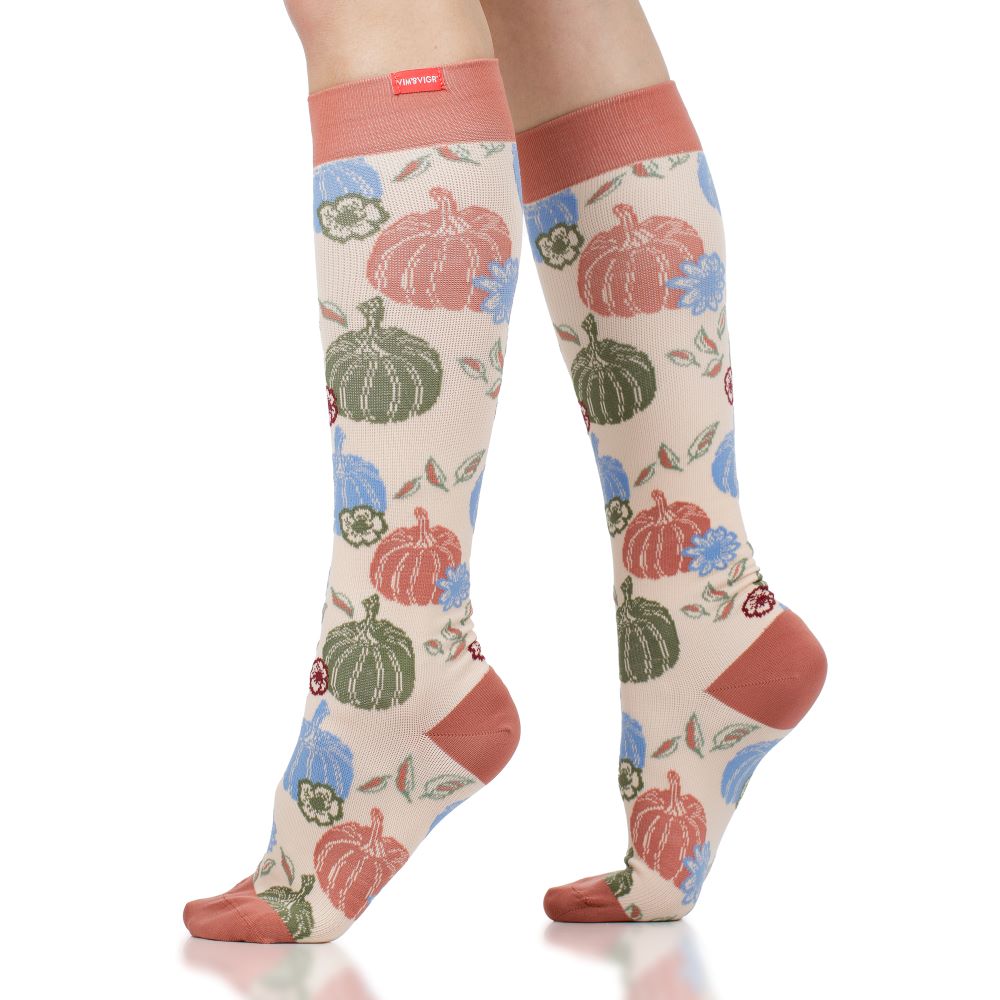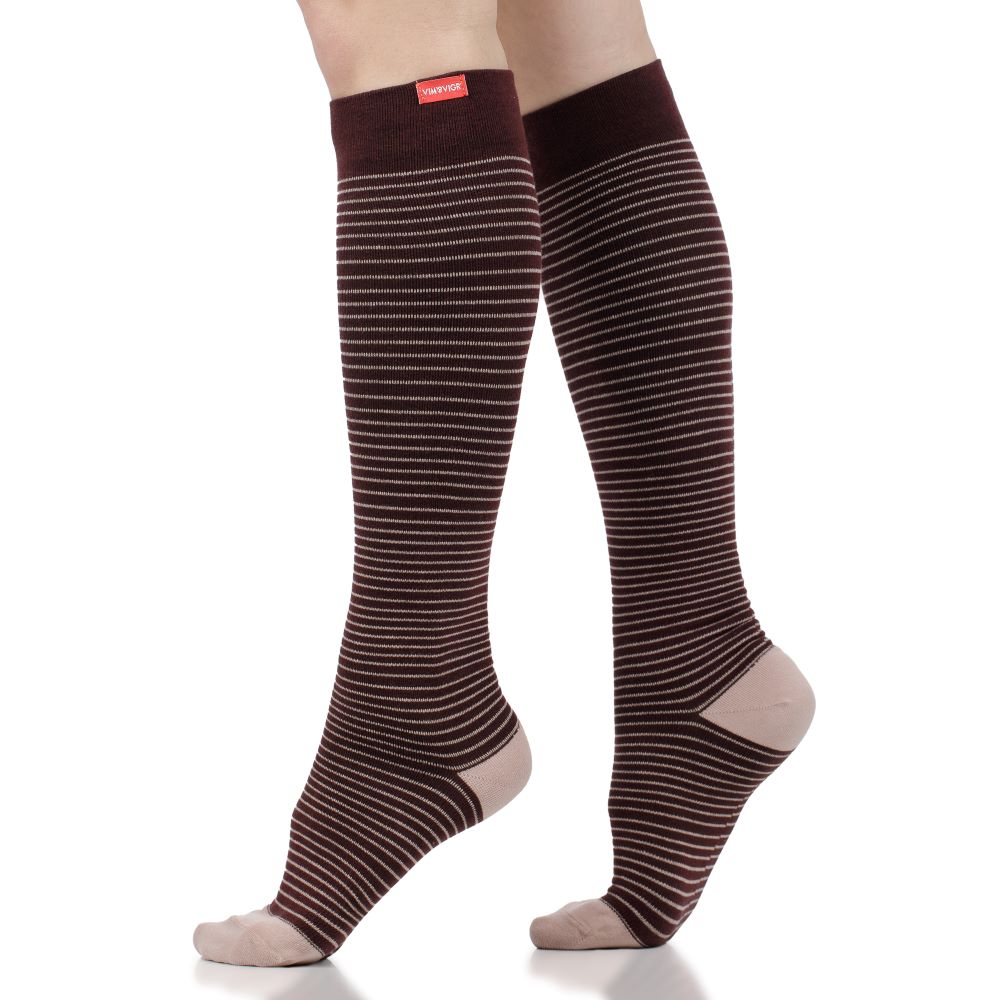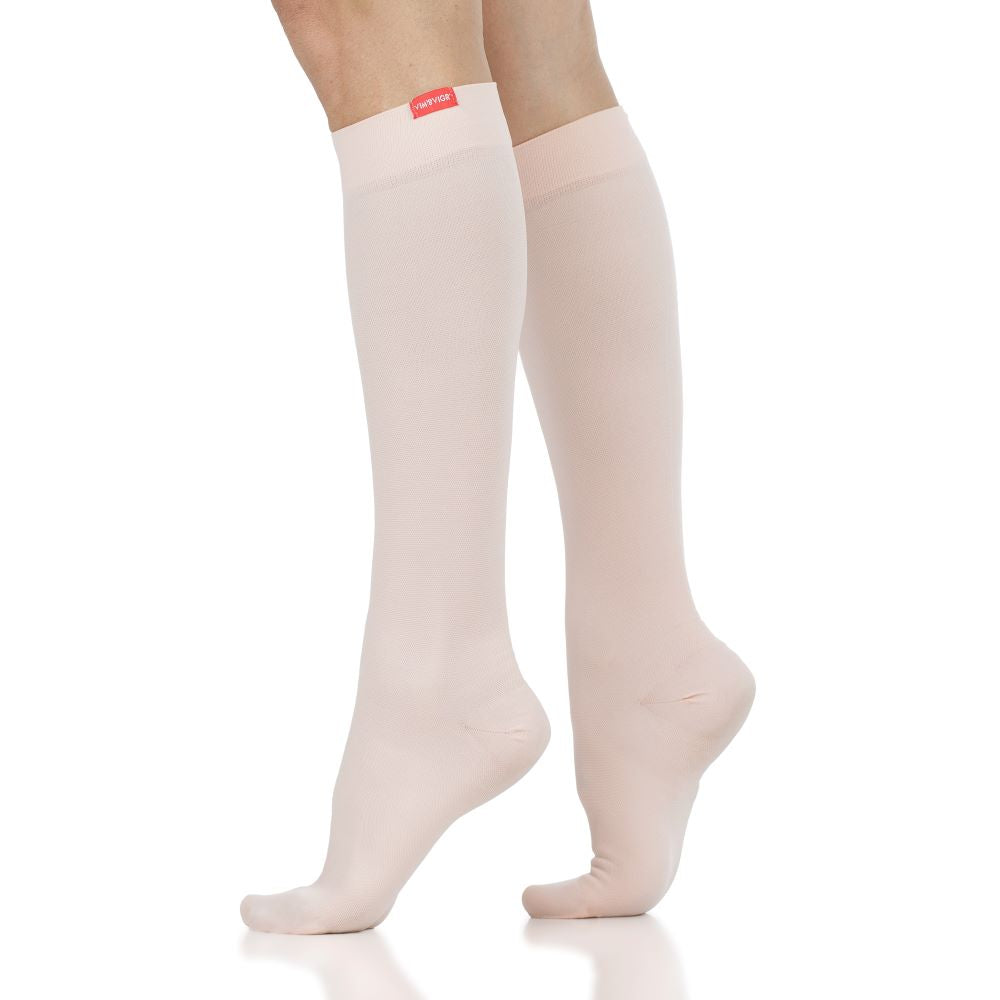How Does Compression Help an Injury?
How can you recover from an injury quicker and relieve pain and swelling effectively? Compression plays a big role in speeding up recovery and can be of great help against swelling and aches and pains after an injury.

In this article, we’ll cover why compression helps promote healing after an injury, explaining what benefits you can get from compression socks and other garments. We’ll discuss which injuries benefit the most from compression, what’s the age-old R.I.C.E. method and how it holds up today, and give you the essential tips on how to use compression to promote recovery and quick healing.
Why Is Compression Good for Injuries?
Compression socks and other garments apply gentle pressure to the part of the body you’re wearing them on. Graduated compression clothing exerts more pressure on the extremity that’s the furthest from the heart. This promotes blood flow away from the high-pressure point towards the lower-pressure area, supporting good blood circulation and avoiding blood clots and fluid build-up.
The effect of graduated compression in cases of injury is twofold: on the one hand, a compression wrap or compression garments promote good blood flow, which helps oxygen and nutrients travel to the area and quicken the natural healing process; on the other hand, compression massages and supports the affected area, stimulating blood circulation so that inflammation and pain is reduced.
Of course, the effectiveness of compression depends on the type of injury and on where you are on your accident timeline (immediately afterwards, or during acute or subacute phases as we’ll cover below). Compression therapy works alongside a number of injury recovery tools, not in isolation.
What Does Compression Do for an Injury?
Thanks to its influence on blood circulation, compression helps speed up recovery from certain injuries. It also plays an important role in reducing swelling, general fluid build-up when you’re immobile, and inflammation.
Reduces Swelling and Inflammation
When we sprain an ankle, we notice that the area swells up and can become bruised and tender to the touch. This is because of inflammation, a sign of which is the accumulation of fluid around the joint injury. Sometimes, swelling goes down relatively quickly. For more severe sprains, it can take a couple of weeks.

Compression socks, in this case, can reduce the swelling and inflammation thanks to how they support blood around your ankle. Unlike medical bandages or compression wraps that can also be effective at supporting blood circulation, a pair of compression socks is easy to put on and convenient to wear while you recover. Moreover, since compression socks prevent more fluid from building up in the lower legs, they reduce the risk of much bigger swelling and painful side-effects.
Promotes Blood Flow and Healing
The role of graduated compression in injury recovery is to push the blood back from the injured area towards the heart. This ensures that your circulatory system continues to work well, despite the injury. There are no clots or build-ups to stop it, which can promote faster healing, too.
The cardiovascular system delivers nutrients and oxygen throughout the body. It also helps transport waste from cells and tissues. The better this whole system stays in motion, the quicker your body can heal naturally.
Provides Support for the Injured Area
A small additional benefit from compression is that it provides some extra support in the injured area. This is particularly helpful for the legs, because exercise causes micro-vibrations that, over time, add up to increase the damage to the lower limbs. So, when returning to running after an injury, having your calf muscles and your joints (e.g. the ankles) be held more firmly in place can help them ease back into exercise.
Additionally, compression socks that provide ankle support and apply gentle pressure to the lower leg can help with recovery from shin splints. Compression can also reduce the likelihood of this type of injury occurring.
Injuries That May Benefit from Compression
So, after what specific injuries can you benefit from wearing compression garments? The most useful cases include injuries to the lower legs, where the action of graduated compression socks can provide topical relief and promote blood flow for quicker recovery and decreased swelling and pain.
Sprains and Strains
An awkward landing, walking on uneven ground, or a strange sudden movement can all lead to a sprained ankle or to strain to the joint. You could also get a sprain in your calf muscle while running or playing sports. In these cases, the injured tendon or muscle will start to hurt and inflammation can make the area swell up and feel warm and tender to the touch.
Wearing compression socks will give you a bit of gentle support, while massaging the injured area without too much pressure. Through this action, blood flow is directed from the lower legs towards the heart, avoiding more swelling and fluid build-up. The increased blood flow will also help deliver more oxygen and nutrients to the muscles and joints, helping the body’s natural healing process.
Overuse Injuries
Overuse injuries occur when you overtrain. This may mean you’re ramping up your running volume a little too quickly, or launch into a very long run without sufficient training beforehand. Shin splints are a common type of overuse injury and can also be caused by running on really hard surfaces, sometimes maybe in inadequate shoes.

Through increased blood flow to the lower legs, compression socks can help speed up recovery from shin splints. Additionally, wearing compression socks for running or walking can help relieve some of the discomfort from shin splints and offer some extra support to the area. The support can be beneficial for preventing shin splints (along with wearing appropriate shoes and increasing your running gradually) in the longer term.
Contusions and Bruises
A contusion forms when blood accumulates outside your veins. This usually happens when capillaries or blood vessels are injured, typically from hitting an area of your body. Contusion is the medical term for a bruise, basically.
Bruising means that there’s a small amount of blood accumulated in an injured area. It can also appear when you’ve sprained your ankle, or even when you give blood. These sort of bruises can heal on their own, but compressing with a wrap or bandage can help reduce swelling and stimulate the blood flow to the area, speeding up the healing process.
Tendonitis
Runners can often suffer from Achilles tendonitis, which can be frustrating and prevent you from working out. Thanks to the pressure they apply to the calf muscles and below the calf, compression socks can relieve some of the swelling and pain when you’re injured.
Achilles tendonitis cannot be easily prevented by wearing compression garments. However, you will get benefits from enhanced blood flow and the recovery massage that compression socks provide in between workouts. There is also a slight benefit from the support provided by compression clothing to the muscles and tendons.
Post-Surgery Recovery
For those who are bedridden after surgery, wearing compression stockings or socks can help prevent the legs from swelling up and blood clots or varicose veins from developing. Maintaining good peripheral circulation is essential during recovery, so you can feel as nimble and light on your feet as possible when you’re back in action. This is why doctors often prescribe compression as part of the recovery protocol after surgery.
What is the R.I.C.E. Method?
Traditionally, the go-to method to recover from an injury is known as R.I.C.E.:
Rest - Stop activity as soon as you feel hurt and rest as much as possible for the first few days;Ice - Apply an ice pack (or some frozen peas) to the affected area to reduce swelling and pain;Compression - Wear compression bandages (such as a medical ACE bandage) to promote blood circulation and prevent swelling. Compression garments are just as effective and easier to wear and remove;Elevation - Raise the sore body part above your head to reduce pain, swelling, and throbbing.
While this method is, in theory, a good approach, more recent research suggests that compression and ice are the MVPs in recovery. Moreover, it appears that moving is better than resting and that it’s important to combine ice and compression with some gentle exercise (physiotherapy), rather than do any of these elements in isolation.
There are some new acronyms that summarize effective post-injury approaches, too. Check out the PEACE and LOVE principles to get some different perspectives!
When to Use Compression in Injury Treatment
Medical advice and research studies agree on the effectiveness of compression in relieving symptoms of injury and supporting quicker healing. Here’s when to use compression to be most effective.
Immediately After the Injury
Right after you’ve got injured, the PEACE principle applies: protect the area from harm, elevate the injured limb, avoid anti-inflammatories, apply compression, and educate yourself on your condition. Gentle compression wraps or light compression level socks can provide relief from swelling and reduce pain and throbbing.
During the Acute Phase
Cold (ice) and compression are routinely advised during the acute phase of an injury to alleviate pain and reduce swelling and inflammation. What’s the acute phase? It includes the time of injury and continues for up to 4 days - this is also called the inflammatory stage.

There are conflicting views over whether we should allow inflammation to occur, since it is believed now that anti-inflammatory action can affect long-term tissue healing. However, compression can keep blood flowing into the affected area during the acute injury phase, which may reduce the amount of swelling and pain. Better blood flow also means quicker recovery, reducing the length of the next phase.
During the Subacute Phase
In the days following the injury, from day 4 onwards, tissues begin to heal and your body focuses on creating new connective tissue and capillaries to help repair any damage. During this period, it’s important to keep blood flow at its best, while also supporting your injured limb and protecting it from re-injury. Wearing compression socks at this point also continues to relieve pain and swelling.
Choosing the Appropriate Compression Device
We’ve established that compression helps during injury recovery, but there are a lot of options out there. Choosing the best source of compression therapy ultimately depends on personal preference.
Compression Socks and Stockings
The most convenient way to apply compression to the legs is by wearing compression socks or stockings. They are easy to put on and remove on your own, they come in a variety of styles and designs, and you can pick different pressure levels depending on your injury and in consultation with your doctor. Wear socks that go up to your knees for injuries to the lower limbs, or go for stockings that climb up the leg to support an injured or sprained knee.
Compression Sleeves
For a more punctual pressure, you can choose compression sleeves, for example for a calf injury or for the arms. Calf compression sleeves are more targeted and won’t support your ankles, but can be beneficial if you need to keep your feet bare.
Elastic Bandages
You can find elastic bandages that apply compression after injury in any pharmacy. The key is to know how to apply these to be the most effective, without putting too much pressure on an injured limb, either. You should consult with the pharmacist or with a medical professional.
Compression Wraps
Similar to bandages, compression wraps can be found in shops and pharmacies. They’re usually a long piece of stretchy cloth that you can wrap around your ankle, for example. It’s best that these are applied by medical professionals at least at first, so you can see the right technique.
Pneumatic Compression Devices
Intermittent pneumatic compression devices were originally marketed for DVT and blood clot prevention. They are now also available for sports recovery, but can be very expensive and cumbersome to wear.
Tips for Maximizing the Effectiveness of Compression
To make the most of your compression socks or other accessories, here are a few tips:
- Always ensure that you’re applying the right level of compression - not too tight, or you may risk cutting off blood circulation; but not too loose, or you won’t’ get any benefit;
- Ensure you wear the right size compression socks for the same reason;
- Consult with medical professionals before using compression if you have any doubts or medical conditions;
- Try compression therapy gradually, without jumping to the most high-performing device or tightests socks right away, especially if this is your first time using this approach;
- Combine compression with gentle movement and physiotherapy, as well as applying cold compresses or ice locally, in consultation with your doctor.
Find your new favorite compression socks and start your injury rehab today!



















Leave a comment